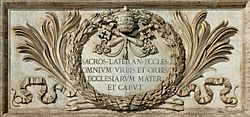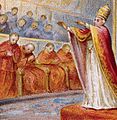Papal supremacy facts for kids
In the Roman Catholic Church, the pope is seen as the highest clergy and as the head of the church. In short, anything the pope says in his function of head of the church is valid for the whole church. The pope has full, supreme, and universal power over the whole Church, a power which he can always exercise unhindered: that, in brief, "the Pope enjoys, by divine institution, supreme, full, immediate, and universal power in the care of souls." This means that the situation of the pope is similar to that of an absolute monarch or the leader of a Fascist state.
Examples of papal supremacy
- Urban II's launching in 1095 of the Crusades, which, in an attempt to recover the Holy Land and territories of the Byzantine Empire which had been conquered by Muslim Seljuk Turks, marshalled European nobility under papal leadership.
- The Papacy determined whom they wished to be the king of various lands by the crowning by Pope Leo III of Charlemagne, first of the Carolingian emperors, rather than a man proclaiming himself king.
Images for kids
-
Pius IX opening the First Vatican Council, illustration. It is during this council that papal supremacy was proclaimed a dogma.
See also
 In Spanish: Supremacía papal para niños
In Spanish: Supremacía papal para niños

All content from Kiddle encyclopedia articles (including the article images and facts) can be freely used under Attribution-ShareAlike license, unless stated otherwise. Cite this article:
Papal supremacy Facts for Kids. Kiddle Encyclopedia.


